Yu-Chien Lin
Jianzhong
Plug-in UL-CSI-Assisted Precoder Upsampling Approach in Cellular FDD Systems
May 31, 2024Abstract:Acquiring downlink channel state information (CSI) is crucial for optimizing performance in massive Multiple Input Multiple Output (MIMO) systems operating under Frequency-Division Duplexing (FDD). Most cellular wireless communication systems employ codebook-based precoder designs, which offer advantages such as simpler, more efficient feedback mechanisms and reduced feedback overhead. Common codebook-based approaches include Type II and eType II precoding methods defined in the 3GPP standards. Feedback in these systems is typically standardized per subband (SB), allowing user equipment (UE) to select the optimal precoder from the codebook for each SB, thereby reducing feedback overhead. However, this subband-level feedback resolution may not suffice for frequency-selective channels. This paper addresses this issue by introducing an uplink CSI-assisted precoder upsampling module deployed at the gNodeB. This module upsamples SB-level precoders to resource block (RB)-level precoders, acting as a plug-in compatible with existing gNodeB or base stations.
Physics-Inspired Deep Learning Anti-Aliasing Framework in Efficient Channel State Feedback
Mar 12, 2024Abstract:Acquiring downlink channel state information (CSI) at the base station is vital for optimizing performance in massive Multiple input multiple output (MIMO) Frequency-Division Duplexing (FDD) systems. While deep learning architectures have been successful in facilitating UE-side CSI feedback and gNB-side recovery, the undersampling issue prior to CSI feedback is often overlooked. This issue, which arises from low density pilot placement in current standards, results in significant aliasing effects in outdoor channels and consequently limits CSI recovery performance. To this end, this work introduces a new CSI upsampling framework at the gNB as a post-processing solution to address the gaps caused by undersampling. Leveraging the physical principles of discrete Fourier transform shifting theorem and multipath reciprocity, our framework effectively uses uplink CSI to mitigate aliasing effects. We further develop a learning-based method that integrates the proposed algorithm with the Iterative Shrinkage-Thresholding Algorithm Net (ISTA-Net) architecture, enhancing our approach for non-uniform sampling recovery. Our numerical results show that both our rule-based and deep learning methods significantly outperform traditional interpolation techniques and current state-of-the-art approaches in terms of performance.
Exploiting Partial FDD Reciprocity for Beam Based Pilot Precoding and CSI Feedback in Deep Learning
May 29, 2022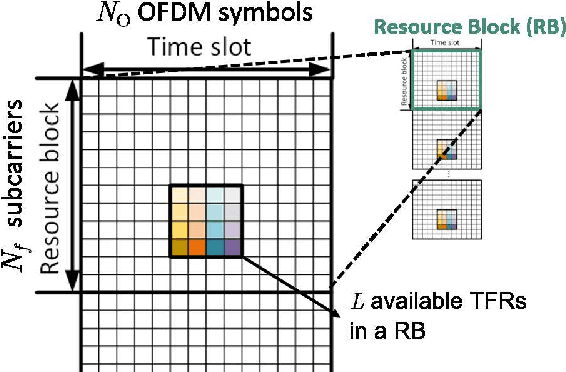
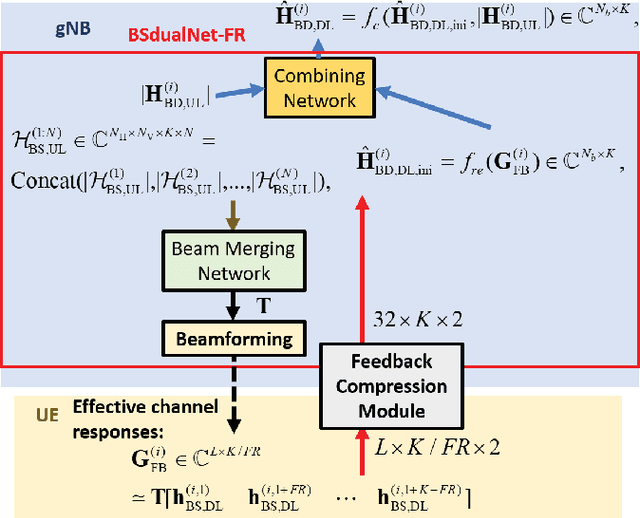

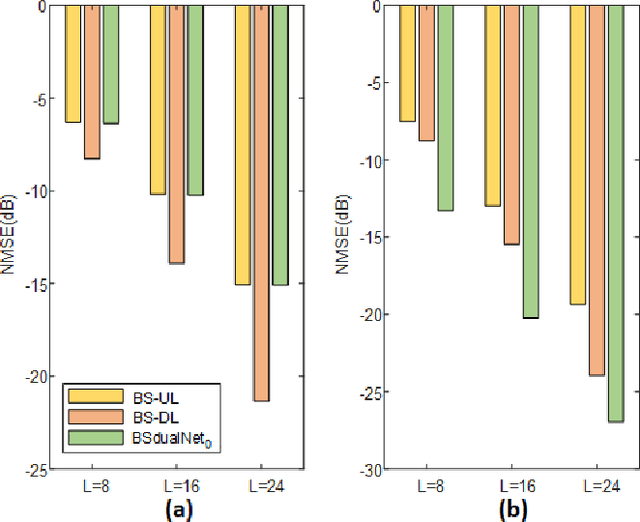
Abstract:Massive MIMO systems can achieve high spectrum and energy efficiency in downlink (DL) based on accurate estimate of channel state information (CSI). Existing works have developed learning-based DL CSI estimation that lowers uplink feedback overhead. One often overlooked problem is the limited number of DL pilots available for CSI estimation. One proposed solution leverages temporal CSI coherence by utilizing past CSI estimates and only sending CSI-reference symbols (CSI-RS) for partial arrays to preserve CSI recovery performance. Exploiting CSI correlations, FDD channel reciprocity is helpful to base stations with direct access to uplink CSI. In this work, we propose a new learning-based feedback architecture and a reconfigurable CSI-RS placement scheme to reduce DL CSI training overhead and to improve encoding efficiency of CSI feedback. Our results demonstrate superior performance in both indoor and outdoor scenarios by the proposed framework for CSI recovery at substantial reduction of computation power and storage requirements at UEs.
A Scalable Deep Learning Framework for Multi-rate CSI Feedback under Variable Antenna Ports
Apr 20, 2022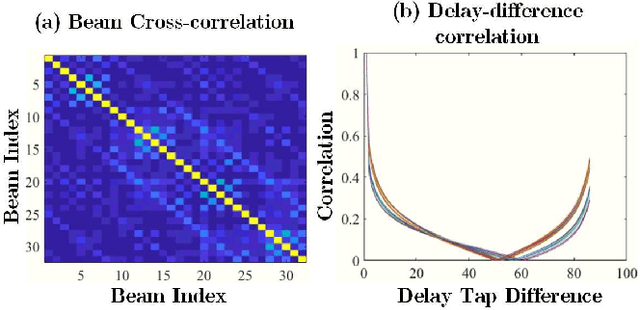
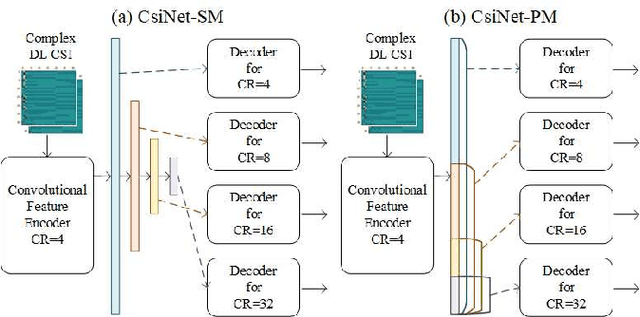

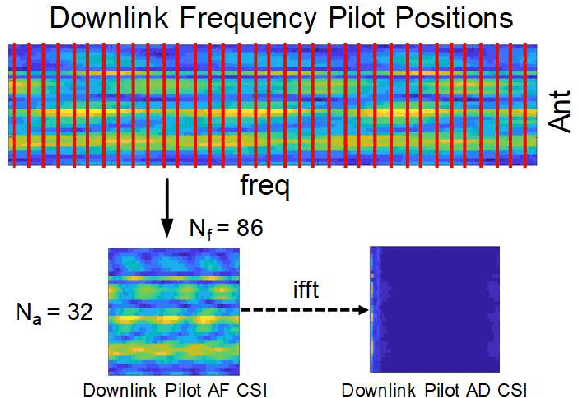
Abstract:Channel state information (CSI) at transmitter is crucial for massive MIMO downlink systems to achieve high spectrum and energy efficiency. Existing works have provided deep learning architectures for CSI feedback and recovery at the eNB/gNB by reducing user feedback overhead and improving recovery accuracy. However, existing DL architectures tend to be inflexible and non-scalable as models are often trained according to a preset number of antennas for a given compression ratio. In this work, we develop a flexible and scalable learning framework based on a divide-and-conquer approach (DCA). This new DCA architecture can flexibly accommodate different numbers of 3GPP antenna ports and dynamic levels of feedback compression. Importantly, it also significantly reduces computational complexity and memory size by allowing UEs to feedback segmented downlink CSI. We further propose a multi-rate successive convolution encoder with fewer than 1000 parameters. Test results demonstrate superior performance, good scalability, and low complexity for both indoor and outdoor channels.
Deep Learning for Partial MIMO CSI Feedback by Exploiting Channel Temporal Correlation
Jan 08, 2022

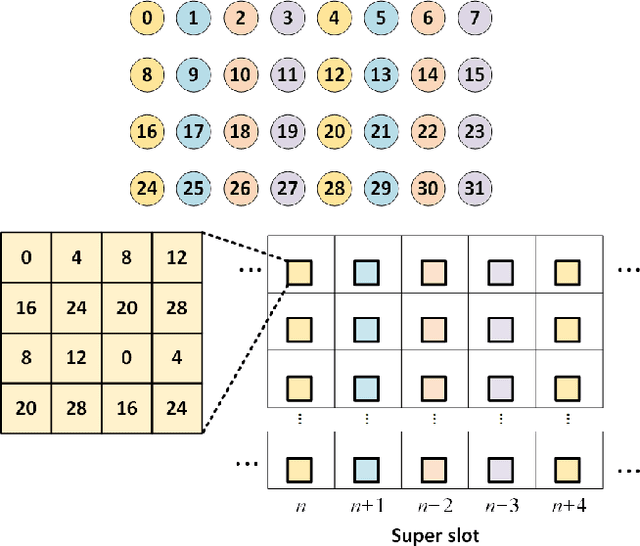

Abstract:Accurate estimation of DL CSI is required to achieve high spectrum and energy efficiency in massive MIMO systems. Previous works have developed learning-based CSI feedback framework within FDD systems for efficient CSI encoding and recovery with demonstrated benefits. However, downlink pilots for CSI estimation by receiving terminals may occupy excessively large number of resource elements for massive number of antennas and compromise spectrum efficiency. To overcome this problem, we propose a new learning-based feedback architecture for efficient encoding of partial CSI feedback of interleaved non-overlapped antenna subarrays by exploiting CSI temporal correlation. For ease of encoding, we further design an IFFT approach to decouple partial CSI of antenna subarrays and to preserve partial CSI sparsity. Our results show superior performance in indoor/outdoor scenarios by the proposed model for CSI recovery at significantly reduced computation power and storage needs.
Learning-Based Phase Compression and Quantization for Massive MIMO CSI Feedback with Magnitude-Aided Information
Feb 28, 2021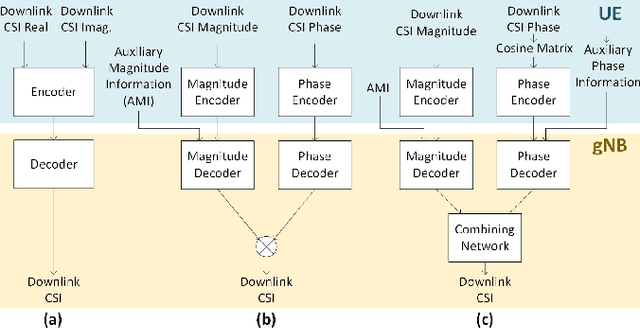
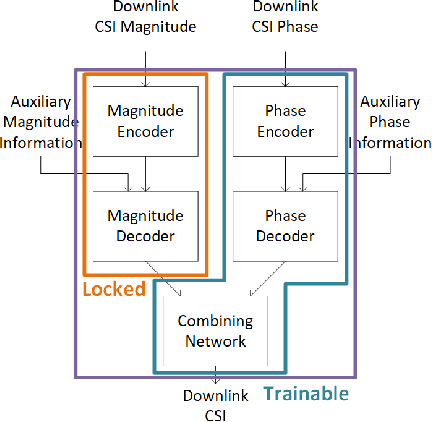
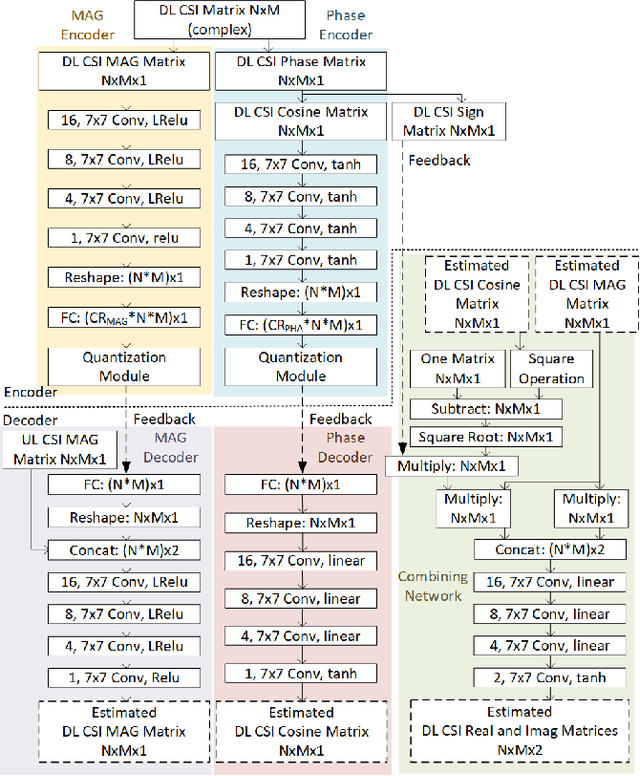
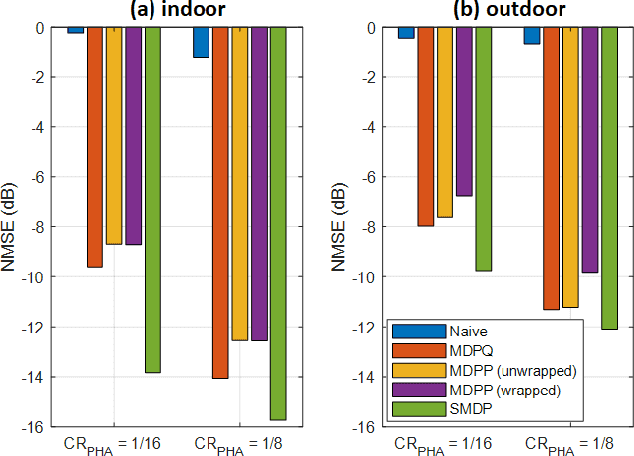
Abstract:In frequency-division duplexing (FDD) massive multiple-input multiple-output (MIMO) wireless systems, deep learning techniques are regarded as one of the most efficient solutions for CSI recovery. In recent times, to achieve better CSI magnitude recovery at base stations, advanced learning-based CSI feedback solutions decouple magnitude and phase recovery to fully leverage the strong correlation between current CSI magnitudes and those of previous time slots, uplink band, and near locations. However, the CSI phase recovery is a major challenge to further enhance the CSI recovery owing to its complicated patterns. In this letter, we propose a learning-based CSI feedback framework based on limited feedback and magnitude-aided information. In contrast to previous works, our proposed framework with a proposed loss function enables end-to-end learning to jointly optimize the CSI magnitude and phase recovery performance. Numerical simulations show that, the proposed loss function outperform alternate approaches for phase recovery over the overall CSI recovery in both indoor and outdoor scenarios. The performance of the proposed framework was also examined using different core layer designs.
 Add to Chrome
Add to Chrome Add to Firefox
Add to Firefox Add to Edge
Add to Edge